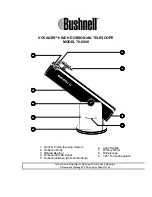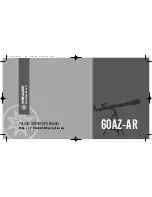
4
5
6. Flexible shafts
In order to facilitate the exact fi ne adjustment of the
declination and right ascension shafts, the fl exible
shafts have been placed on the holders of both these
shafts, in the places designed for that purpose.
The long fl exible shaft is mounted parallel to the
telescope tube. It is secured with a clamp screw on
the designated indentation on the shaft.
The short fl exible shaft is mounted sideways. It is
secured with a clamp screw on the designated
indentation on the shaft. Your telescope is now ready
for use.
Using the Telescope
Observation
After you have located the North Star in the fi nder, you
will be able to recognize the North Star when you look
through the eyepiece of the telescope. If needed, you
can angle the telescope even more exactly toward the
star (with the help of the fl exible shafts), or you can
adjust the focus with the focus knob.
Additionally, you can now switch to a higher
magnifi cation by changing the eyepiece (to a smaller
focal length). Please be aware that the magnifi cation
of the stars is barely perceptible.
TIP:
Eyepieces are lens systems designed for your
eye. In an eyepiece, the clear image that is generated
in the focal point of a lens is captured (in other words,
made visible) and magnifi ed still more. Eyepieces
with various focal lengths are necessary in order to
achieve various degrees of magnifi cation. Begin each
observation with an eyepiece with a low magnifi cation
(large focal length, e.g. 20 mm).
Finding stars
In the beginning, you will certainly fi nd it diffi cult
to orient yourself in the sky, since stars and
constellations are always moving, and their position
in the sky varies according to the season, date,
and time. The North Star is an exception to this. If
you were to imagine the polar axis of the Earth
extending out into space, it would approximately
hit the North Star. The so-called north celestial
pole is the starting point for all star charts.
On the drawing you see a number of the more
familiar constellations and star clusters, which
are visible throughout the year. The position of the
stars is, of course, dependent on date and time.
If you have fi xed your telescope on one of these
stars, you will notice that within a short time it
disappears from the eyepiece fi eld of vision. In
order to compensate for this effect, operate the
fl exible shaft of the counterweight axis, and your
telescope will follow the apparent path of this star.
Storing the Telescope
Hopefully your observation session will have
been interesting and successful; afterwards, it
is recommended to store the telescope in a dry
and well-ventilated room. Please do not forget
to place the lens caps back onto the front tube
opening and the eyepiece holder. All eyepieces
and optical accessories should also be stored in
their respective containers.
NOTE:
Make sure the focuser is closest to the
object which you are trying to view. If the focuser
is not closest to the object the telescope is facing
backwards and the view will not be of the ground
and dark or black.
Possible objects for observation:
We have compiled and explained a number of
very interesting celestial bodies and star clusters
for you but we suggest that you start practicing
during the day focusing on terrestrial objects
such as Birds and or Trees at varying distances
from you.
This is just for practice, the T1000HD
telescope is not designed for terrestrial
viewing - NOTE Images will be upside down and
backwards.
On the accompanying images at the
end of the instruction manual, you can see how
objects will appear in good viewing conditions
through your telescope at varying powers (see
pictoral examples on the following page).
Capella
Perseus
Cassiopeia
Deneb
Cepheus
Ursa Minor
(Kleiner Bär)
Ursa Major
(Großer Bär)
Draco
(Drache)
Wega
Polaris
(Polarstern)
Summary of Contents for T1000HD ASTRO NOVA
Page 2: ...2 12 Fig 6 8 6 7 10 5 1 2 3 9 4 11 ...
Page 8: ...8 8 6 7 10 5 1 2 3 9 4 12 Fig 6 11 ...
Page 14: ...14 11 12 Fig 6 8 6 7 10 5 1 2 3 9 4 ...
Page 19: ...19 ...































